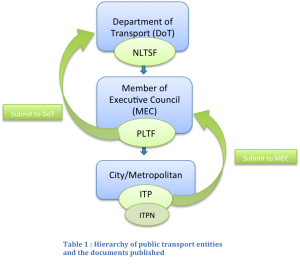Urban Transport Planning in South Africa
National
context for urban transport planning
Transport in South Africa is organized around three different scales: the national, provincial and metropolitan/city scale.
The national scale is the first stakeholder involved in this hierarchy. The DoT’s (Department of Transport) main role is to coordinate the different scales and provide its guidelines through the NLTSF (National Land Transport Strategy Framework). This document contains the national transport strategies and instructions that lower-scale stakeholders must follow. The DoT is also in charge of allocating the transport budget for the provinces or municipalities.
The provincial scale comes second. South Africa is organized into nine provinces, each of them being led by a distinct Executive Council. Transport is managed by a MEC (Member of the Executive Council), specifically in charge of these purposes. Each province produces a PLTF (Provincial Land Transport Framework) designed to link national and local policies. The role of the provinces towards the municipalities is more advisory than regulatory.
Finally, the last stakeholders involved are municipalities and metropolitan entities. They are the contracting authorities and perform regulatory functions. These functions are part of the post-apartheid decentralization policy initiated in 1994 by the government that confers more power to the municipalities. As a result, municipalities are now regarded as the reference for urban transport. They exert their authority through their main transport documents: ITP (Integrated Transport Plan) and ITPN (Integrated Transport Plan Network).
It is crucial that any document part of this hierarchy complies with the higher-level plans and policies.
ITP and IPTN: two complementary documents
ITP stands for Integrated Transport Plan. This document issues global transport strategies, considering every transport mode in the metropolitan/city area. The local authorities have to produce an ITP, which is a 5-year plan, being reviewed every year through a consultation process. This process implies meetings between all stakeholders and citizens, to initiate discussions about transport issues and to improve the current strategies. ITPs are meant to be public and are available on the authorities’ websites.
IPTN stands for Integrated Public Transport Network. This document is associated with the ITP and follows its strategies but it focuses more specifically on the implementation of the public transport network, within the same metropolitan area. The IPTN involves all modes of transport including non-motorized transport and comes in addition of the ITP.
Explanation through the case of Cape Town
In Cape Town, the authority in charge of urban planning is TCT (Transport for Cape Town). This entity has been created in October 2012, after the success of the 1st phase of the BRT project in Cape Town, to enable a more efficient management of urban transport within Cape Town’s municipality. The last ITP was published in 2013 and will be enforced for a period of five years.
This latest version is a 283-page document and entails an important level of detail. This ITP has adopted an interesting progressive approach, with short, medium and long-term objectives. In the pursuit of effectiveness, the ITP also proposes a local approach for some of the objectives. Besides, for each project proposed by TCT, a very detailed budget is submitted and studied. One of the interesting points is that the ITP is exclusively based on recent surveys and hence, strategies are based on accurate and reliable data.
We can nonetheless highlight two important criticisms. Firstly, some goals are drown into a too high number of objectives and, secondly, none of the targets are quantified. However, in comparison with the first ITP (2006-2011), we can notice substantial efforts to structure the document.
Each ITP is different and not always as structured as the Cape Town one. However, the ITP is an opportunity for the south african cities to organize their mobility. As far as Cape Town’s ITP is concerned, it is well structured and completely in accordance with the European urban planning guidelines. Hence, it can easily be considered as a European SUMP (Sustainable Urban Mobility Plan) and be a source of inspiration for the rest of South Africa or even Sub-Saharan African cities.
